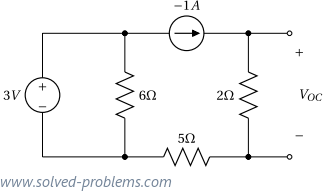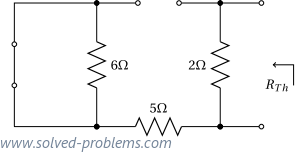Use Thévenin’s theorem to determine ![]() .
.

Solution
Lets break the circuit at the ![]() load as shown in Fig. (1-27-2).
load as shown in Fig. (1-27-2).
You may also watch the video of solving the problem below:
Also pdf version of the solution is available here.

Now, we should find an equivalent circuit that contains only an independent voltage source in series with a resistor, as shown in Fig. (1-27-3).

Unknowns are ![]() and
and ![]() .
. ![]() is the open circuit voltage
is the open circuit voltage ![]() shown in Fig. (1-27-2).
shown in Fig. (1-27-2).
It is trivial that the current of ![]() resistor is equal to the current of the current source, i.e.
resistor is equal to the current of the current source, i.e. ![]() . Therefore,
. Therefore, ![]() . The Thévenin theorem says that
. The Thévenin theorem says that ![]() . Please note that it is not saying that
. Please note that it is not saying that ![]() is the voltage across the load in the original circuit (Fig. (1-27-1)).
is the voltage across the load in the original circuit (Fig. (1-27-1)).
To find the other unknown, ![]() , we turn off independent sources and find the equivalent resistance seen from the port, as this is an easy way to find
, we turn off independent sources and find the equivalent resistance seen from the port, as this is an easy way to find ![]() for circuits without dependent sources. Recall that in turning independent sources off, voltage sources should be replace with short circuits and current sources with open circuits. By turning sources off, we reach at the circuit shown in Fig. (1-27-4).
for circuits without dependent sources. Recall that in turning independent sources off, voltage sources should be replace with short circuits and current sources with open circuits. By turning sources off, we reach at the circuit shown in Fig. (1-27-4).

The ![]() resistor is short circuited and the
resistor is short circuited and the ![]() one is open. Therefore, their currents are zero and
one is open. Therefore, their currents are zero and ![]() .
.
Now that we have found ![]() and
and ![]() , we can calculate
, we can calculate ![]() in the original circuit shown in Fig. (1-27-1) using the Thévenin equivalent circuit depicted in Fig. (1-27-3). It is trivial that
in the original circuit shown in Fig. (1-27-1) using the Thévenin equivalent circuit depicted in Fig. (1-27-3). It is trivial that![]() .
.
We used the Thévenin Theorem to solve this circuit. A much more easier way to find ![]() here is to use the current devision rule. The current of the current source is divided between
here is to use the current devision rule. The current of the current source is divided between ![]() and
and ![]() resistors. Therefore,
resistors. Therefore,![]()
Now, replace the current source with a ![]() voltage source as shown below and solve the problem. The answers are
voltage source as shown below and solve the problem. The answers are ![]() ,
, ![]() and
and ![]() . Please let me know how it goes and leave me a comment if you need help 🙂
. Please let me know how it goes and leave me a comment if you need help 🙂


i am sorry, but wouldn’t the Rth be 1.6 ohm ? not 10/7
6 ohm is short circuited by the voltage source, so Rth=2||5=(2*5)/(2+5)=10/7 ohm. Please let me know if you need more explanation.
sir plz can u explain me about super position theorem and thevenin’s thorem and problems…would u plz tell me the way to solve prblms
Please browse the site carefully. These topics are already covered.
thevenin’s theorem
Sir,
I’m a 1st year student i need to get a page that explains Independent source
along with examples for VDCS, CDCS , CDVS,VCVS
Since the 5 ohm resistance is open circuited why would the current would go in 5 ohm resistance, the current will only flow through 2 ohm resistance, hence the Rth will be 2ohm.
Absolutely correct
hi, Rth is 2ohm because there is a short circuit in network.
That is not a reason
whts the reason dat we got rth =2
As current passing through 5ohm and 6 ohm is zero as they are open circuited
I also think that the Rth is 2 ohm because all the other resistances goes into short circuit. . . .! isn’t is?
You have replaced -1A current source to -1V voltage source that is why values you got are mismatched.
its very good
i need help to find Vth
$latex 6 \Omega$ resistor is in parallel with 3V voltage source. the series combination of $latex 2 \Omega$ and $latex 5 \Omega$ resistors is connected to the series combination of 3V and -1 volt voltage sources. Therefore, $latex V_{5\Omega}+V_{2\Omega}=3V+(-1V)=2V$. $latex V_{Th}$ is in fact the voltage across the $latex 2\Omega$ that can be found by voltage division rule: $latex V_{Th}=V_{2\Omega}=\frac{2\Omega}{2\Omega + 5\Omega} \times 2 V= \frac{4}{7} V$
i am not able to understand
i also …. at the end what you do when 2v.vth after this line i cant under stand what you have done.. please help me…
also explain the voltage division rule…
that`s very helpful can you give us more examples 😀
Have you checked out this example?
please explain me thevenin theorem with two volt sources and only with three resistors.
how we will know that it is short or open circuit plz
yes but i need examples where there are two independent sources
I am going to add some soon 🙂
I am also in process of writing a new ebook which will include Thévenin’s Theorem too.
wow that would be great sir , me waiting for that ebook
that would be great but please harry i had an exam soon and i`m completly lost and when you finish the book please tell us 🙂
I’ll try my best 🙂
How do we solve Thevenin equivalent circuit problem with combination of dependent and independent sources?
(voltage and current)
The solution follows a similar procedure, you need to find $latex V_{th}$ and $latex R_{th}$. To find $latex V_{th}$ any method can be used. However, to find $latex R_{th}$, the best way is to connect a 1 V voltage(or 1 A current) source to the output and find the current passing through it (or voltage drop on the terminal, if you are using a current source). $latex R_{th}$ is $latex \frac{V_{voltage source}}{I_{voltage source}}=\frac{1 V}{I_{voltage source}}$ (or $latex \frac{V_{current source}}{I_{current source}}=\frac{V_{current source}}{1 A}$, if you are using a current source). I am planning to add an example soon.
this problem is really good
In fig(1-27-4) 6 ohm resistance is in series wid 5 ohm resistance w.r to 2 ohm….if 6 ohm is open thn how 2 ohm is parallel wid 5 ohm….?
It is not precise to say that 6 ohm is in series with 5 ohm with respect to 2 ohm. Two resistors cannot be in series with respect to some other element. Two resistors (or any element) are in series if one of their terminals are connected to each other and the have same current.
2 ohm is not parallel with 5 ohm either.
I thought that this problem it’s good to begin, after to do more problems, the thevenin’s theorem will be eaasy.
However, this it’s a good begin for the newbies.
Thank you Sophie.
sir i want solve the norton’s theorems in three loop cricuit../
Why did u replace the voltage source with the current source ???
That is a new problem. Has nothing to do with the original problem. Just to practice more.
sir , i couldnt find Io=4/31 value….
i tried by the steps given below….
1. find total current I = Vth/(Rth || RL) = 30/31
2.find current flowing thru load IL= I * 2/(2+3) = 12/31( my answer)
sir pls let me know, where i did mistake
Thanks & regards,
THIRU.
Vth, Rth and RL all are in series (always) as shown in Fig. (1-27-3). Therefore, IL=Vth/(Rth+RL)= 4/31A
excellent !!!!!!
i didnt understand when ma teacher taught on board…..nw i got!!!!
thnk u vry much sir…
Thank you sir. now i can understand better
isnt the 5ohm resistor also short circuited in the 2nd example? how do u find rth for it?
No, $latex 5 \Omega$ is not short circuited. Only $latex 6 \Omega$ is short circuited. Hint: $latex R_{th}=2 \Omega || 5 \Omega$. Let me know if you still need help.
i dont knw wat to do first when i see this problem in question paper sir….
pls tell me the procedures to do like hint sir….. thank you
The Rth is 2ohm not the 10/7ohm
You have replied on the first comment that it wouldn’t be 2 ohm but how it is possible
When we short all voltage source than it would be only 2ohm so The total Rth will be 2ohm……If i am wrong plz explain……!!!
Now i understand sir sorry sorry
It is ok 🙂
sir its very gud example to know about the thevnins example & get idea to how to calculate this example wid simple steps..so,thnx a lot
Sir , why is 6 ohm source is shot with the voltage source and we just take 2 and 5 ohm resistances for equivalent resistance
In calculating, replace voltage sources with short circuits. Therefore, element which are in parallel with voltage sources are short circuited.
im confused. in the problem you said that RTH=2 ohms but in your replies you say that RTH=10/7. So what is it really?
Fo the homework (Fig (1-27-5) ), it is $latex R_{th}=\frac{10}{7}\Omega$ but for the solved problem (Fig. (1-27-1)) it is $latex R_{th}=2\Omega$.
can u give us an example on how to get Rth with dependent sources?
helpful and thank you professor:)
You are very welcome!
can u help me with some more problems to workout… kindly give a reply
Sure. I can help as much as my free time allows me.
sir, Can you please help me solving the circuit with two loops, two sources and Load Resistance is independent of both of them.
dear Dr. Yaz am having problems in coming up with equations, especially when using nodal analysis. is there a solution to this problem sir?
can you solve any thevenin problem with a dependent source in it?
Sir i couldn’t find Rth. Although i could calculate Vth and Io correctly. Plz explain how Rth is 10/7 ohm. i’m gettin 22/13ohm.
Hint: It short circuit at the 6ohm resistor.
i wiuld like to be help with analysing nortons two loop network
Nortons two loop network analysis
can you please help me out wit more examples…….am clear with this problem……thank you sir
sir can you give me some of your reference books about electrical engineering
[img]doc1[/img]
sir how can i solve the current at 25 ohm by using thevenin’s theorem???
awesome sir plz it will be my pleasure if u can upload some more examples thank you..
sir,what are the steps to solve a network having only dependent sources using Thevenin’s theorem.
thanku sir…bt i m very weak in these…can u give some more examples so that i can undrstnd it more..
Sir, may i know what to do when we have 5 indepntent sources
3 voltage source and 2 current source????
please reply soon!!!!
circuit theorem is a hand tool for electrical/electronics engineering,
its good but u solve the problem by using formulas line by line
here i did not get that how the Vth is found.i thought that Vth =-1v.is this correct?
No, sorry!
It is -2 for the example and $latex \frac{4}{7}$ for the homework.
What would Rth be if the current and voltage were switched around or would Rth be the same?
In that case, $latex R_{th}=2\Omega || (5\Omega+6\Omega)=\frac{2\times 11}{2+11}=\frac{22}{13}=1.69 \Omega$. No, it won’t be the same.
YOU HAVE DONE A GOOD JOB SIR……… JUST ADD MORE SOLVED EXAMPLES … … THOUGH I HAVE MY PAPER ON 31ST OCT ,i am asking it coz for the benefits of other students,,, btw thank you..
In finding Vth, can i presume that the 3V source has no effect. why the -1A current source is only taken into account for calclation of Vth.
Thanks in advance
This is true only for this example of course. Here, $latex V_{th}$ is the voltage of a resistor whose current is known. So, $latex V_{th}$ can be easily found and the 3V source has no effect in $latex V_{th}$.
how 5ohm resister is open in Rth….???
To see this clearly, remove the $latex 6\Omega $ resistor because it is short circuited and no current would pass though it.
sir please tell me why we short the voltage source and open the current source while finding the R thevenin?
sir please tell me
when we find the resistance equivalent why we short the voltage source and open the current source
This method to find the $latex R_{th}$ is only valid for circuits without dependent sources. In this method, we are in fact replacing the sources with their equivalent internal resistance. The internal resistance of a voltage source is zero. The reason is that there can be a situation (short circuit) where the voltage across the source is a constant number and the current passing through it is infinite, Therefore, the internal resistance is $latex \frac{V}{\infty}=0$. For a current source, the internal resistance is infinite. This is because there can be a situation (short circuit) where the voltage across a current source is zero while the current is a constant number $latex \frac{0}{I}=0$.
thanxs sir
Sir please give me the examples of dependent source on the superposition topic.
Superposition Method – Circuit With Dependent Sources
sir,
in rth 5ohm resistor is left bcoz current will enter it flow through short circuit but will then stop flowing due to open circuit am i right plz tell me?
Yes, you are right. The current cannot flow due to the open circuit. 6 ohm parallel with short circuit (0 ohm) is short circuit. So, we can remove that 6 ohm and see that the 5 ohm is not connected anywhere, so current cannot pass through it.
sir plaese give some more tips to solve the problems i don’t understand it
can u discuss the problem related to find power to a particular resistanceor any element,and a lot of voltage source and current source are given.
thanks. from that example i will be able to do my exam briliantly.
sir,
i am facing problem with dependent source while solving Rth . sir i have also prob. while solving maximum power transfer theorem question. i am preparing for GATE 2012.
please mail me with some prob. and solution.
thanks a lot. i have solved the example and assignment also.
my answers are correct as you have given.
kindly tell me how can we select the refrence node in node-voltage method????
what is mean by independent?
hello, sir
do you have any doc file related to using Laplace Transform in electric circuits like a Transistors or an Op-Amp. if yes kindly mail me aur send me a link.
i’ll be very greatful to you.
Sir pls what about kirchoff‘s law? I don‘t understand it all…pls help me out sir
sir another method we hav read to find Rth is to first find short circuit (isc) and then by relation Rth=Vth/isc.
now how in the above given example we can actually CALCULATE the isc first and then Rth?
please its confusing me.do reply sir
thank u.
sir iwant some problems on thbnins theorem
dnt knw da spelling of”thevenin”>?????????
gadha 😛
first thanks u very-very much,sir. Please tell me some more example;which is based on thevenin’s theorem.
it really great,openin this page,pls hw can we calculate a resistance equivalent where only different resistances are given between a and b and the circuit is short circuited
Hello sir, To find the Vth for the problem in Fig 1-27-5, I used superposition theorem. First I shorted the 3V source and found E1= 13/7 V. Then I shorted the -1V source and found E2= -2/7 V. Adding them I found the Vth = 11/7 and Io= 11/31. That doesn’t match with your answer Vth=4/7. Where did I make mistake? Is it okay use superposition theorem for this problem. Is there any easier way? Please give me an answer.
Sir plz suggest me some of your reference books as your books are very helpful and easy to understand.I really need them.My exams are imminent…….. yours way of explaining a topic is awesome.
too easy problem..evn my baby promy can solve thhat 😉
i want solutions of different nodal circuit diagarms
I don’t understand how we get the value of Rth i.e. 2ohm?
if Vth is 2 v that would result in a 7v on the branch where I source is place.But the voltage that it can have is 3V ,,from the left branch!!!!!is their any mistakes
Why aren’t you considering the 3V source while determining the Vth or Voc?
plz give a detailed lecture on source transformation in linear circuits.
Sir, if the 5 ohm resistor is not taken, even the 2 ohm resistor should not be taken too. right ? because one side of the 2 ohm resistor is in the open circuit ??
actually it can be said that both sides are open circuits. However, we need seen from two terminals of
seen from two terminals of  .
.
sorry sir how can i solve a question which have two independent (voltage source & current source) and dependent voltage source?
THE SOLVED PROBLEMS THAT ARE UPLOADED ON THE WEBSITE WILL NOT BE ENOUGH FOR US TO GET THE CONCEPT PROPERLY.I SUGGEST THAT YOU ADD MORE RELEVANT QUESTIONS SO THAT WE W’LL KEEP OURSELVE BUSY ALWAYS
sir ,,,, is voltage source is considered if it is present near the terminals A-B across the the thevenins is calculated
sir just explain how
you know that 6 ohm resistor is parallel to the voltage source,and explain why 5 ohm resistor is not short circuited
How to find Vth in problems when the AB terminals are open circuited in the middle of the circuit?
It is basically the same. Middle of circuit, left hand side, top, right, … do not matter!
Fairly certain there’s a mistake in the answer for the second problem:
I calculate the same Req as you have, but using loop analysis, the current in the 2ohm resistor is 4/7A giving a Vth value of 8/7V not 4/7V. This gives a value of Io = 8/31A. I get the same value completing the whole problem with loop analysis.
No! it is not. The voltage is 3+(-1)=2 and the current becomes 2/(2+5)A.
Yes, you are correct. I also posted this. I verfied with SPICE.
Sir,what is the meaning of short circuit.I can’t understand it…
Sir what is the meaning of short circuit…
Hello Yaz, the last circuit with the -1 volt substituted for the -1amp current source. You have Vth=4/7 but that is current that goes through the 5 Ohm and 2 Ohm resistors, not Vth. I spiced up the circuit to verfiy. Please check it out when you have time. I know you did this a long time ago. Thanks for your examples.
My bad, the 3 volt and 1 volt source are opposing I drew the circuit incorrect.
How u change this -1A current to 1V in above ckt and except this I m getting ur method
Hi broo! In the 2nd one the -1A current source is changed into -1V voltage source sum the I2 value is 4/7 but we need to find Vth so Vth = I2*2=8/7 is the answer . I think so
even i got the same answer ……grave mind …8/31